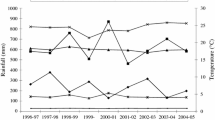Abstract
Nutrient uptake and balance of the cotton (Gossypium hirsutum L.) + pigeonpea (Cajanus cajan(L.) Millsp.), a traditional strip intercropping system practiced on the rainfed Vertisols of central India is not known to us. On-farm participatory trials were conducted on 10 farmer fields, five each on medium deep (MDS) and deep soils (DS) of Nagpur, central India to determine the effect of technological interventions on N, P and K uptake of cotton and pigeonpea. The nutrient balance was also quantified as a difference of nutrient inputs and removal. Nutrients accumulated by the crops (grain, stalk and leaves) and weeds removed off the field by hand weeding were considered as nutrient removal, while fertilizer was considered as nutrient input. The interventions included application of recommended dose of fertilizer (RDF), RDF + conservation tillage with in situ green manure (CT1) and CT1 + application of ZnSO4 (CT2) and compared with farmers’ practice (FP). Nutrient uptake, in general, was higher on DS than on MDS. Among the interventions, N, P and K uptake of cotton and pigeonpea followed the order: CT2 > CT1 > RDF > FP. Mean N and P balance was positive in all the treatments. The balance may become negative if nutrient losses are accounted. A negative K balance was observed in all the treatments and the magnitude was the greatest for the FP plots (−39.4 kg ha−1 y−1). In spite of fertilizer-K application in the intervention plots, K balance was negative (−14.4 to −19.5 kg ha−1 y−1). By way of leaf and fruit drop, cotton and pigeonpea litter recycled 12.2 kg N, 1.7 kg P and 6.7 kg K ha−1 y−1
Similar content being viewed by others
References
J. Arihara N. Ae K. Okada (1991) Root development of pigeonpea and chickpea and its significance in different cropping systems C. Johansen K.K. Lee K.L. Sahrawat (Eds) Phosphorus Nutrition of Grain Legumes in the Semi-arid Tropics ICRISAT HyderabadIndia 157–165
M. Bekunda G. Manzi (2003) ArticleTitleUse of the partial nutrient budget as an indicator of nutrient depletion in the highlands of southwestern Uganda Nutr. Cycl. Agroecosys. 67 187–195 Occurrence Handle10.1023/A:1025509400226 Occurrence Handle1:CAS:528:DC%2BD3sXmvVOmtbY%3D
D. Blaise C.D. Ravindran (2003) ArticleTitleInfluence of tillage and residue management on growth and yield of cotton grown on a vertisol over 5 years in a semi-arid region of India Soil Till. Res. 70 163–173 Occurrence Handle10.1016/S0167-1987(02)00153-8
Blaise D., Majumdar G. and Tekale K.U. 2005. On-farm evaluation of fertilizer application and conservation tillage on productivity of cotton and pigeonpea strip intercropping on rainfed Vertisols of central India. Soil Till. Res. (in press). DOI: 10.1016/j.still.2004.09.016.
D. Blaise J.V. Singh A.N. Bonde K.U. Tekale C.D. Mayee (2005) ArticleTitleEffects of farmyard manure and fertilizers on yieldfibre quality and nutrient balance of rainfed cotton (Gossypium hirsutum) Biores. Technol. 96 345–349 Occurrence Handle1:CAS:528:DC%2BD2cXotlSrs7s%3D
D.J. Boquet G.A. Breitenbeck (2000) ArticleTitleNitrogen rate effect on partitioning of nitrogen and dry matter by cotton Crop Sci. 40 1685–1693 Occurrence Handle10.2135/cropsci2000.4061685x
K.G. Cassman B.A. Roberts T.A. Kerby D.C. Bryant S.L. Higashi (1989) ArticleTitleSoil potassium balance and cumulative cotton response to annual potassium additions on a vermiculitic soil Soil Sci. Soc. Am. J. 53 805–812 Occurrence Handle1:CAS:528:DyaL1MXltleiur0%3D Occurrence Handle10.2136/sssaj1989.03615995005300030030x
T.J. Gerik B.S. Jackson C.O. Stockle W.D. Rosenthal (1994) ArticleTitlePlant nitrogen status and boll load of cotton Agron. J. 86 514–518 Occurrence Handle10.2134/agronj1994.00021962008600030011x
N.R. Hulugalle L.A.L. Bruyn Particlede P. Entwistle (1997) ArticleTitleResidual effects of tillage and crop rotation on soil properties, soil invertebrate numbers and nutrient uptake in an irrigated vertisol sown to cotton Appl. Soil Ecol. 7 11–30 Occurrence Handle10.1016/S0929-1393(97)00027-9
Jha D. and Sarin R. 1984. Fertilizer use in semi-arid tropical India. ICRISAT Research Bulletin No. 9, International Crops Research Institute for the Semi Arid Tropics, PatancheruHyderabadIndia76 pp.
J.C. Katyal (1988) Nitrogen fertilizers-their use and management in the Indian semi-arid tropics C.B. Christianson (Eds) Proceedings of the Colloquium Soil Fertility and Fertilizer Management in Semi-arid Tropical India IFDC Muscle Shoals, AL 61–70
T. Otani N. Ae (1996) ArticleTitlePhosphorus (P) uptake mechanisms of crops grown in soils with low P status. II. Screening crops for efficient P uptake Soil Sci. Plant Nutr. 42 155–163 Occurrence Handle1:CAS:528:DyaK28XitVyks7g%3D
S.P. Palaniappan K. Annadurai (1995) ArticleTitleFertilizer use in cotton – based cropping systems Fertilizer News 40 73–77
R. Prasad (1998) A Practical Manual for Soil Fertility Divison of Agronomy, IARI New Delhi 50
R. Prasad J.F. Power (1991) ArticleTitleCrop residue management Adv. Soil Sci. 15 205–251
T.J. Rego V.N. Rao B. Seeling G. Pardhasaradhi J.V.D.K. Rao (2003) ArticleTitleNutrient balances-a guide to improving sorghum- and groundnut-based dryland cropping systems in semi-arid tropical India Field Crops Res. 81 53–68 Occurrence Handle10.1016/S0378-4290(02)00199-5
U. Solaiappan A.A. Dason (1998) ArticleTitleInfluence of sowing timeintercropping and mulching on the growth and yield of rainfed cotton (Gossypium hirsutum) Indian J. Agron. 43 616–621
R. Thakur G. Sahay A.K. Sarkar (1990) ArticleTitleNutrient balance in acid sedentary soil (Haplustalf) of Ranchi as influenced by crop sequences J. Ind. Soil Sci. 38 233–236 Occurrence Handle1:CAS:528:DyaK3MXht1Skt7k%3D
S. Tobita O. Ito R. Matsunaga T.P. Rao T.J. Rego C. Johansen T. Yoneyama (1994) ArticleTitleField evaluation of nitrogen fixation and use of nitrogen fertilizer by sorghum/pigeonpea intercropping on an alfisol in the Indian semi-arid tropics Biol. Fertil. Soils 17 241–248 Occurrence Handle10.1007/BF00383976
Wani S.P., Rupela O.P. and Lee K.K. 1994. BNF technology for sustainable agriculture. In: Proceedings of the Transactions of the 15th World Congress of Soil ScienceSymposia Papers III, AcapulcoMexico10–16 July. International Society of Soil Science and Mexican Society of Soil Sciencepp. 245–262.
A. Whitbread G. Blair K. Naklang R. Lefroy S. Wonprasaid Y. Konboon D. Suriya-arunroj (1999) ArticleTitleThe management of rice straw, fertilisers and leaf litters in rice cropping systems in Northeast Thailand. 2. Rice yields and nutrient balances Plant Soil 209 29–36 Occurrence Handle10.1023/A:1004519031550 Occurrence Handle1:CAS:528:DyaK1MXltFGisrY%3D
Author information
Authors and Affiliations
Corresponding author
Rights and permissions
About this article
Cite this article
Blaise, D., Bonde, A.N. & Chaudhary, R.S. Nutrient Uptake and Balance of Cotton + Pigeonpea Strip Intercropping on Rainfed Vertisols of Central India. Nutr Cycl Agroecosyst 73, 135–145 (2005). https://doi.org/10.1007/s10705-005-0073-5
Received:
Accepted:
Issue Date:
DOI: https://doi.org/10.1007/s10705-005-0073-5




